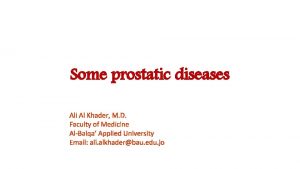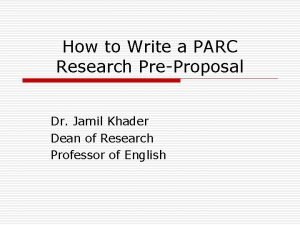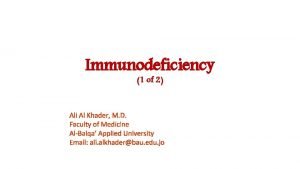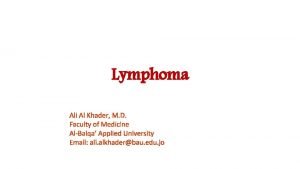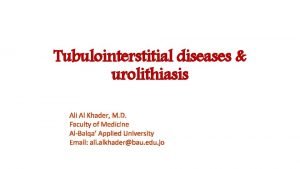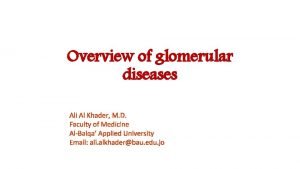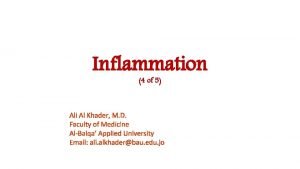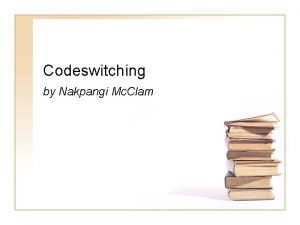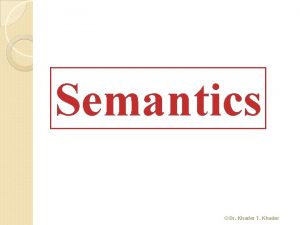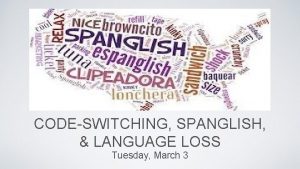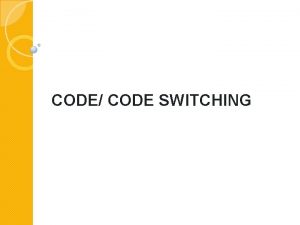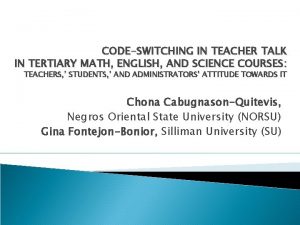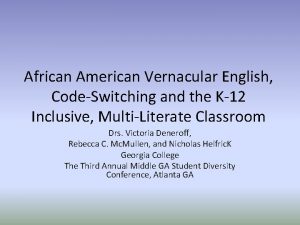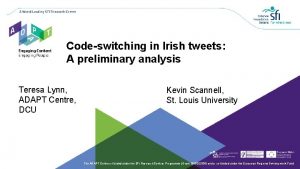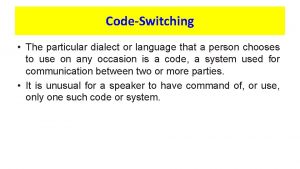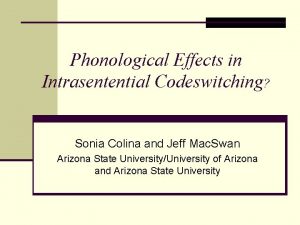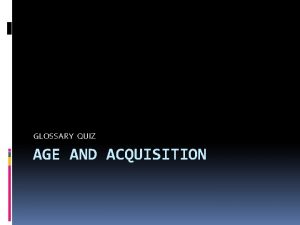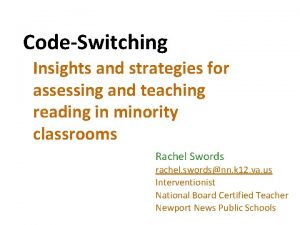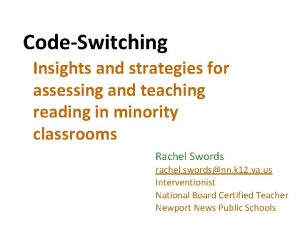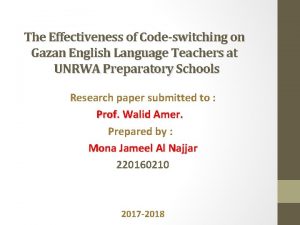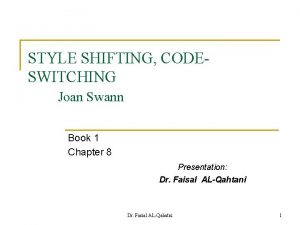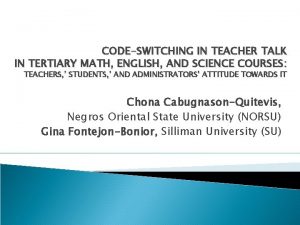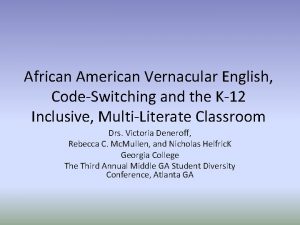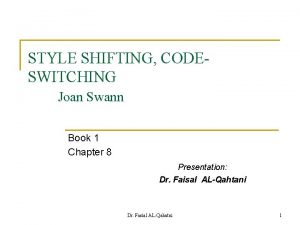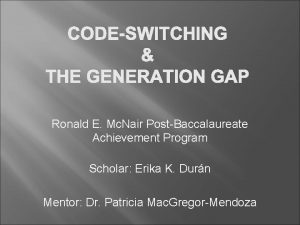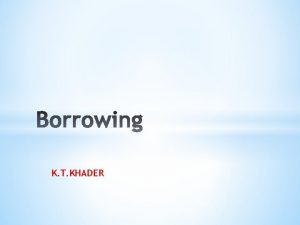K T KHADER CODESWITCHING CS 1 CODESWITCHING CS










































- Slides: 42

K. T. KHADER CODE-SWITCHING ( CS ) 1

CODE-SWITCHING ( CS ) � The result of language contact in bilingual communities is that people may shift in their speech from one language to another. This is codeswitching , a rather common phenomenon in the speech of bilingual and multilingual individuals. Briefly speaking , CS refers to the use of more than one language by participants in the execution of a speech event or speech act. 2

� Consider the following from a conversation between two Arab bilingual women may exemplify one type of code-switching. Notice the alternation between English and Arabic which occurs between sentences , or within the same sentence : � - Hello Noor. How are you ? Shuu Akhbaarik ? � - Al hamdu lillaah , fine. Thank you. wein kunti mbaarih ? � - Went to the movies with Huda. reitik kunti ma 9 aana. kan l-filim fantastic � 3

� Crystal (1987) suggests that code, or language, switching occurs when an individual who is bilingual alternates between two languages during his/her speech with another bilingual person. A person who is bilingual may be said to be one who is able to communicate, to varying extents, in a second language. 4

� This includes those who make irregular use of a second language, are able to use a second language but have not for some time (dormant bilingualism) or those who have considerable skill in a second language (Crystal, 1987). This type of alteration, or code switching, between languages occurs commonly amongst bilinguals and may take a number of different forms, including alteration of sentences, phrases from both languages succeeding each other and switching in a long narrative. 5

� As a result, the speaker may be triggered into speaking in the other language for a while. This type of code switching tends to occur when the speaker is upset, tired or distracted in some manner. Secondly, switching commonly occurs when an individual wishes to express solidarity with a particular social group. Rapport is established between the speaker and the listener when the listener responds with a similar switch. 6

� This type of switching may also be used to exclude others from a conversation who do not speak the second language. An example of such a situation may be two people in an elevator in a language other than English. 7

� Others in the elevator who do not speak the same language would be excluded from the conversation and a degree of comfort would exist amongst the speakers in the knowledge that not all those present in the elevator are listening to their conversation. 8

� The final reason for the switching behavior presented by Crystal (1987) is the alteration that occurs when the speaker wishes to convey his/her attitude to the listener. Where monolingual speakers can communicate these attitudes by means of variation in the level of formality in their speech, bilingual speakers can convey the same by code switching. 9

� Crystal (1987) suggests that where two bilingual speakers are accustom to conversing in a particular language, switching to the other is bound to create a special effect. These notions suggest that code switching may be used as a socio-linguistic tool by bilingual speakers. 10

� From the above discussion, it may be concluded that code switching is not a language interference on the basis that it supplements speech. Where it is used due to an inability of expression, code switching provides a continuity in speech rather than presenting an interference in language. 11

� The socio-linguistic benefits have also been identified as a means of communicating solidarity, or affiliation to a particular social group, whereby code switching should be viewed from the perspective of providing a linguistic advantage rather than an obstruction to communication. 12

� Further, code switching allows a speaker to convey attitude and other emotives using a method available to those who are bilingual and again serves to advantage the speaker, much like bolding or underlining in a text document to emphasise points. Utilising the second language, then, allows speakers to increase the impact of their speech and use it in an effective manner. 13

WHY DO PEOPLE CODE-SWITCH? � The topic, � the solidarity with the listener, � the social setting, � all these have been suggested as factors that motivate people in codeswitch. The motivation may not be conscious. � In some extreme cases, people may not even be aware they have codeswitched. 14

KINDS OF CODE-SWITCHING � SITUATIONAL occurs when the speaker changes the language because of the change in the situation. � One language is used in one situation (for example during a breakfast with the family members) the other in a different one (e. g. in government offices) � 15

METAPHORICAL � occurs when a change of the topic of the discourse requires a change in the language used. � Thus, a language used in a situation which is different from the one it is usually used in, because the topic of the conversation is one that is associated with the situation it is usually used in. 16

� � CS can be within two unrelated ( or related ) languages ( Arabic ---- English ) or two varieties of the same language ( Standard Arabic---Spoken Arabic ). Code switching may be viewed as an extension to language for bilingual speakers rather than an interference and from other perspectives it may be viewed as interference, depending on the situation and context in which it occurs. 17

� This conclusion is drawn from the notions that switching occurs when a speaker: needs to compensate for some difficulty, express solidarity, convey an attitude or show social respect (Crystal, 1987; Berthold, Mangubhai and Bartorowicz, 1997). 18

� The switching also occurs within postulated universal constraints such that it may be integrated into conversations in a particular manner (Poplack, 1980; Cook, 1991). On this basis, given that it occurs within a particular pattern, potential for code switching to interfere into a language exists. 19

� Code-switching is the practice of moving between variations of languages in different contexts. Everyone who speaks has learned to code-switch depending on the situation and setting. In an educational context, code-switching is defined as the practice of switching between a primary and a secondary language or discourse. 20

CODE MIXING The change of codes within a simple utterance without any associated topic change. � occurs when you incorporate small units (words or short phrases) from one language to another one. It is often unintentional and is often in word level. � the language codes are used � intrasententially � in code mixing there is a base code that is used and has its own function and autonomy, whereas the other codes involved are not more than pieces without having function or autonomy as a code. 21

� � � Refers to linguistic behaviour of a bilingual speaker who imports words or phrases from one of his/her languages into the other one. Numan and Carter define code mixing as, a “phenomenon of switching from one language to another in the same discourse. ” According to Berthold, Mangubhai and Bartorowiez 1997, code mixing occurs when speakers shift from one language to the other in the midst of their conversation. Thus this definition accommodates inter-sentential switching and intra-sentential mixing both under the term code switching. 22

REASON OF CODE-MIXING � � � � � A. Interjection B. Quoting somebody else C. Expressing group identity D. Because of real lexical need E. Talking about a particular topic F. Repetition used for clarification G. Being emphatic about something H. To soften or strengthen request or command I. Intention of clarifying the speech content for interlocutor J. To exclude other people when a comment is intended for only a limited audience 23


DIGLOSSIA KTKHADE R 25

History of Diglossia The term diglossia was introduced into the English language literature On sociolinguistic By Charles A. Ferguson (1959). In order to describe the situation found in places like Greece , the Arabic-speaking world In general , German speaking Switzerland the island of Haiti –a list which can easily be extended (A. Hudson 1994) Charles A. Ferguson (1959) Diglossia is relatively stable language. Language situation , in which in the addition of primary dialect. Of the language there is a divergent highly codified superposed variety which is learn largely by formal education and is used for most written and formal spoken purpose. 26

� � � � � Diglossia is a linguistic situation where two va rieties of the same language exist to fulfil different social functions. Ferguson (1959 a: 336) defines diglossia as A relatively stable language situation in which, in addition to the primary dialects of the language (which may include a standard or regional standard), there is a very divergent highly codified (often grammatically more complex) superposed variety, the vehicle of a large and respected body of written literature, either of an earlier period or of another speech community, which is learned largely by formal education and is used for most written and formal spoken purposes, but is not used by any sector of the community for ordinary conversation. 27

Fishman(1980) Diglossia is enduring societal arrangement , and extending at least beyond A three generation period such as two language each have their secure phenomenologically legitimate and widely implemented functions. E. g. in Fishman’s usage even multilingual countries such as Nigeria where English language is nation wide prestige language which is learnt in school and local language such as Hausa Yoruba are spoken natively as described as being diglossic. 28

Definition of Diglossia is a kind of situation where two variation of language Happens in same time Its not a dialect. If a language is dialect that language will not be called diglossia. 29

Variation of Diglossia High variety Low variety Formal Informal Friendly , Slang , Vulgar Official Professional 30

FUNCTION OF DIGLOSSIA Standard (High) Non-Standard (Low) Sermon Instruction of servants Speech of Parliament Conversation with friends University Lecture Conversation in tea-stall Newspapers Editorial Conversation With Children Serious work in literature 31

Formal & Informal English Ø Formal English is used in “serious” texts and situations — for example, in official documents, books, news reports, articles, business letters or official speeches. Ø Informal English is used in everyday conversations and in personal letters. 32

Methodology 1. Face to face discussion. 2. Collect Our data to speaking with them. 3. Analysis data from conversation. 4. Discussion with Salesman. 5. Discussion with student.

Prestige Speakers consider High as the more powerful to Low in a number of respects. E. g. High variety is more beautiful, logical and expressive than the Low variety. 34

Acquisition Low is usually used by adults while speaking to children and children use it among each other. The High variety is ‘taught’, whereas the L variety is ‘learned’. 35

Standardization There are usually no comparable grammars, dictionaries and standardized texts for the Low variety, and any view of that variety is likely to be highly pejorative in nature. There is an established norm for pronunciation, grammar, and vocabulary which allows variation only within certain limits. 36

Grammar The grammar of the Low variety is generally simpler. For instance, fewer distinctions in the L variety are marked by the use of grammatical suffixed. There also major differences in the vocabulary of the two varieties. E. g. Standard German has four cases in the noun; Swiss German has only three cases in the noun. 37

Lexicon Generally, most of the vocabulary between the High and Low varieties is shared, with some variations in form and with several differences in use and meaning. For the most part, the High variety will contain technical terms and more ‘learned’ expressions. 38

Phonology The sound systems of High and Low constitute a single phonological structure of which the Low variety phonology is the basic system and the divergent features of the High phonology are either a subsystem or a Para system. 39

Conclusion Diglossia is one for the important thing to us. In diglossia, no-one speaks the High variety as a mother tongue, only the Low variety. In the Standard-with-dialects situation, some speakers speak High variety as a mother tongue, while others speak Low varieties as a mother tongue and acquire High as a second system. 40

41

SALAMAT � ILA AL LIQA’A FI NEXT CLASS � � � K. T. KHADER 2015 42
